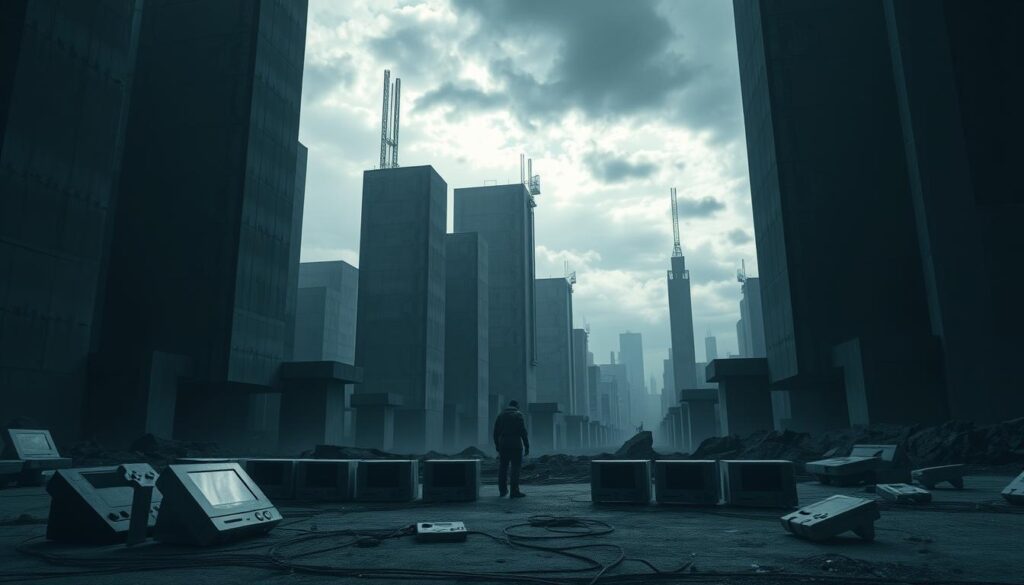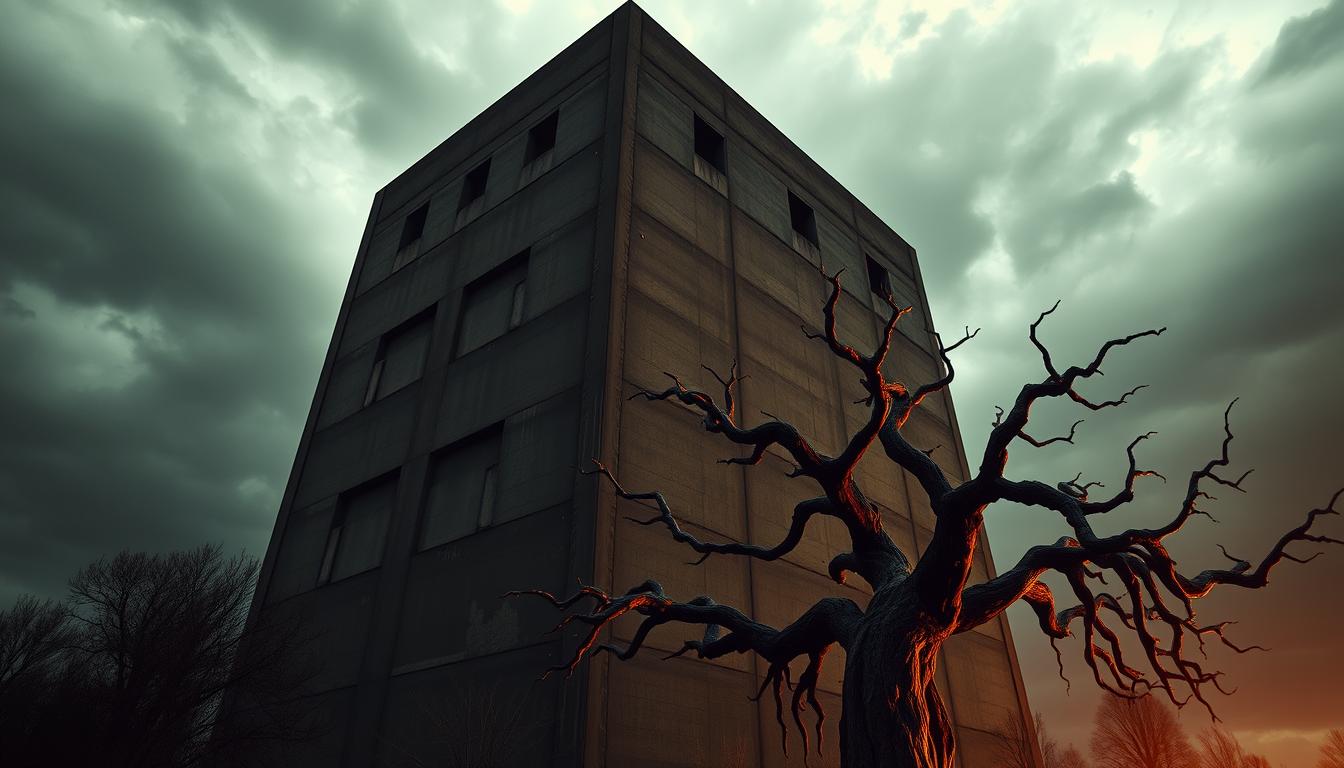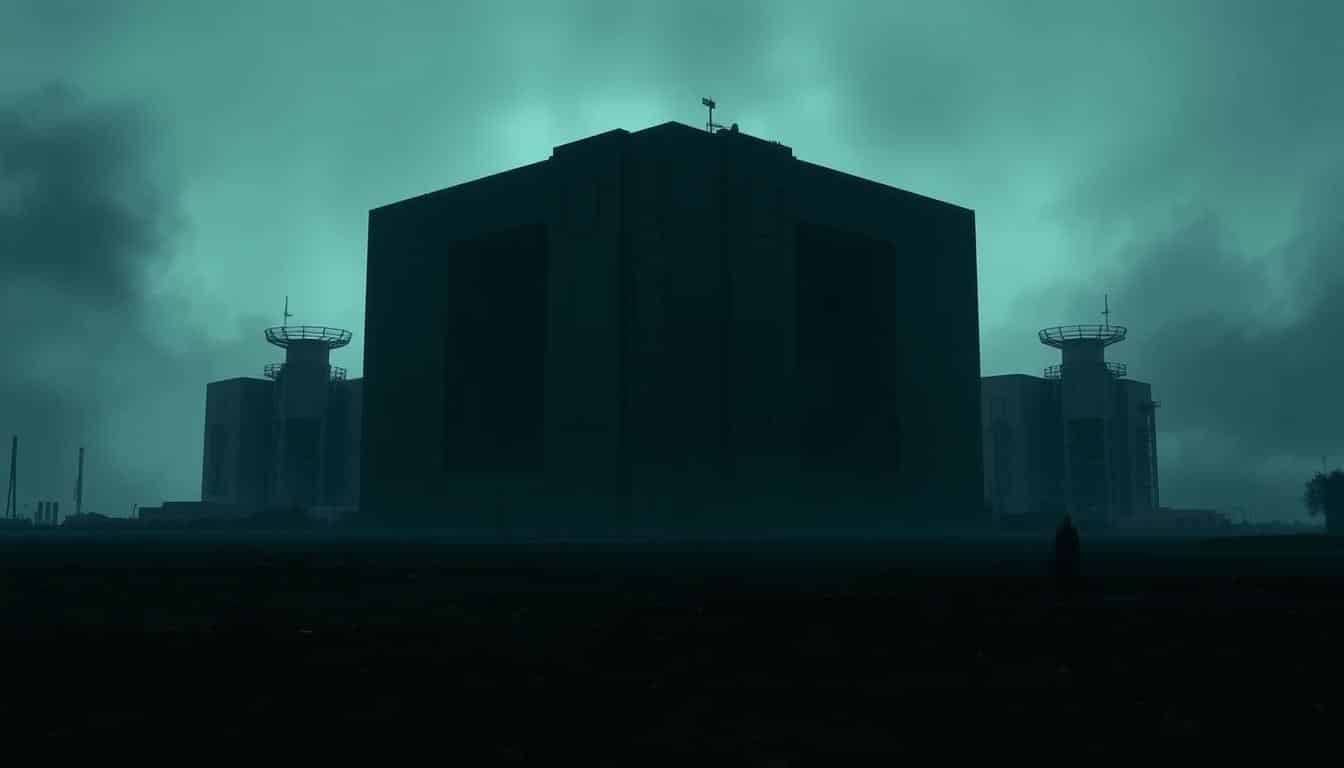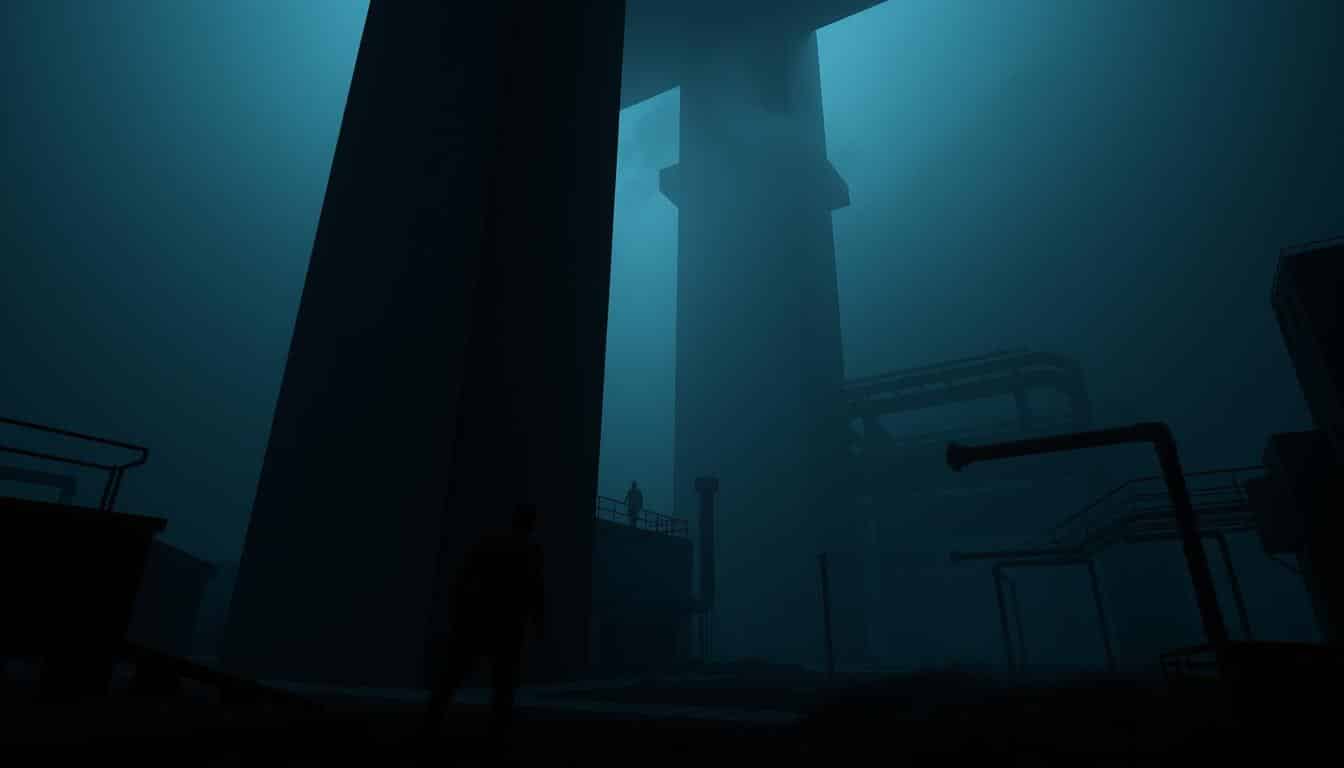The mix of brutalist aesthetics and horror gaming has made gaming more immersive. This style, known for its bare concrete look, adds to the mood and depth of many games. It helps us see how simple, yet powerful designs make games feel more eerie and strange.
This approach not only changes how games look but also affects their stories. By diving into brutalism, we learn how it creates spooky settings. This article will dig into how brutalist environments impact the experience, especially in horror games.
The Origins of Brutalist Architecture in Gaming
Brutalism, a bold style from the mid-20th century, greatly influences gaming and other creative areas. Its raw concrete and geometric shapes match video game themes well. The style’s history links to game emotions, especially in horror.
Historical Context and Development
After World War II, brutalism emerged with a focus on basic, functional buildings. By the 1990s, games like Quake and GoldenEye began using brutalist ideas. This brought players into cold, harsh worlds. It deepened feelings of loneliness and control in games.
Influence on Game Designers
Today’s game creators still draw from brutalism to stir emotions. They follow architects like Le Corbusier, adding brutalist touches to games. This unique style helps tell deeper stories. Designers use brutalism’s history to engage and sometimes frighten players.

Understanding Brutalism’s Aesthetic Qualities
Brutalism shows the beauty of raw concrete in designs focused on use. This style’s big, simple forms fit well in horror games. Players find themselves in worlds filled with unease and alienation. This makes their experience better.
Concrete and Monolithic Structures
Concrete is key in brutalist design, showing strength and lasting quality. It’s different from other styles’ fancy designs. In games, these big structures make things feel spooky. They match the scary stories. Players move through large, simple spaces. These spaces make them feel scared and exposed.
Emphasis on Functionality over Ornamentation
Function is more important than looks in this architecture. This idea is popular in horror games. They build spaces that boost the game action. Such designs connect players closely with the story. Every part of the game world matters. The simplicity of brutalism adds depth, making gamers dive deeper into the spooky stories.
The Impact of Brutalist Aesthetics on Horror Gaming Experiences
Brutalist aesthetics have a big role in horror gaming. The stark, raw vibe of brutalism makes games feel eerie. This style, with its concrete and few decorations, makes players feel alone and sad. Games using brutalism pull players into creepy worlds, making them feel more involved.
Creating Eerie Atmospheres
Brutalist architecture in horror games makes everything scarier. By playing with light and dark, designers make visuals that scare. For example, the game F.E.A.R. uses light in scary ways to pull players into the game. The hard, cold look of brutalism makes you feel uneasy, perfect for horror games.
Playing on Players’ Emotions and Fears
Feeling scared is key in horror games, and brutalism adds a lot to this. Developers mix scary visuals with sounds to mess with your fears. Moving through these games, the look and feel make players scared and anxious. This mix of brutalism and horror makes players face their fears in a deep way, leading to an intense game time.
Notable Horror Games Featuring Brutalist Elements
Brutalist design plays a vital role in horror games. It creates an eerie feeling that adds to the game’s tension. By looking at specific examples, we see how brutalism makes the gaming experience richer.
Case Study: NaissanceE
NaissanceE uses brutalist design in a unique way. Players explore a world of concrete that tricks the eye. This makes the game more tense and unsettling as you move through it.
Case Study: Control
In Control, brutalism adds to the game’s heavy feel. The big, bulky buildings show themes of power and control. This setting makes players feel small and adds depth to the story’s power struggles.
Case Study: Layers of Fear
Layers of Fear uses brutalist styles to up the scare factor. Its use of sharp, hard lines makes the story more intense. Brutalism here deepens the game’s psychological impact, proving its worth in horror storytelling.
Brutalism as a Tool for Psychological Horror
The look of brutalist buildings is perfect for creating a spine-chilling vibe. Their big, simple forms make you feel small and alone. Walking through these areas makes the scary parts of games feel even more real, pulling you into a world filled with nervous energy.
Creating Alienation and Isolation
Brutalist places seem empty and cold on purpose. They’re designed to make you feel cut off from everything. As you move around, the loneliness gets stronger, helping the game’s scary theme hit harder. This type of architecture makes you feel lost in a place that doesn’t care about you.
Building Uncertainty and Tension
Brutalist architecture also makes games more tense and uncertain. Game makers use these settings to make you feel scared and confused. The big, faceless buildings make you feel at risk. Every turn might bring something scary, keeping you always worried. This way, the game shows the real fears we all face in a world that can feel too big and strange.
Player Reactions to Brutalist Environments
Players often have mixed feelings about brutalist environments. Some love the bold, striking design. But others might feel uneasy in these harsh spaces. This blend of reactions fuels conversations in gaming circles. It helps developers shape future games.
Fascination vs. Discomfort
Brutalist designs pull players in opposite directions. Many admire their raw, powerful beauty, which adds depth to the game. These settings can make emotions stronger, drawing players deeper into the game world. Yet, some players feel these harsh spaces are too much, impacting how they enjoy the game.
The Role of Community Feedback
Player feedback is key in tweaking brutalist game environments. Developers listen to what players say to improve their creations. Working together, they make sure these unique spaces feel right for players, balancing unease with engagement.
Explorations of Power and Control in Gaming
Architectural design is key in shaping stories in games, especially horror ones. Brutalist buildings often show power themes. They make us feel both trapped and curious. Games use these settings to deepen the feeling of being in a world where control matters a lot.
How Architecture Reflects Themes of Authority
Brutalist architecture stands as a strong symbol in many games. Its bold look helps tell a story of power. Gamers move through spaces that show themes of rule and resistance. This makes gamers see the environment not just as a setting but as part of the story. They face the power it shows.
The Dystopian Underpinnings of Brutalism
Dystopian architecture in horror games brings out feelings of being left out and scared. As players go through these spaces, they see signs of a world falling apart under control. This is key to making the game’s emotional side strong. The clear lines of brutalist design make power struggles more real to gamers. Each design choice makes the game world’s authority more powerful and scary, adding to the horror.
Emerging Trends: The Future of Brutalist Aesthetics in Horror Gaming
The gaming world is changing, with indie developers leading the way. They are choosing brutalist designs to make their games stand out. This style helps create unique game experiences different from the usual.
Games are now focusing more on the story and how it makes you feel, instead of just looks. Using brutalist elements can tell stories in new ways that really get to players. This new direction shows how architecture can shape the way we play games.
Conclusion
Exploring brutalist aesthetics shows a big impact on horror games that’s more than just how things look. By looking at where it comes from, what it’s like, and how it makes people feel, we see it shapes not only the game world but also how players feel while playing. Brutalist aesthetics make fear, loneliness, and uncertainty stronger, making the game feel more real.
Horror games like Control, NaissanceE, and Layers of Fear show how brutalism adds to the scare factor. These games use brutalism’s unique style to bring out fear and unease. This makes the game stories break new ground. With indie developers using this style, new ways of mixing architecture and story are on the horizon.
To wrap up, as games keep changing, brutalist ideas will play a bigger role, helping create not just scary places but also deep themes. How architecture and game design work together is key to making horror games that truly stand out. It’s an exciting time for horror games, with brutalism making a lasting impact on the genre.



